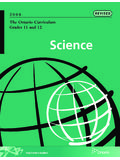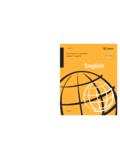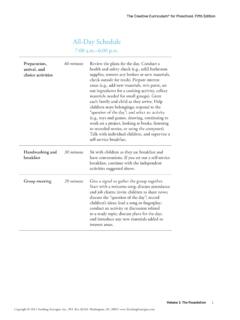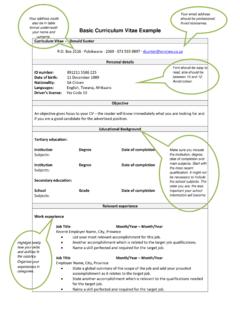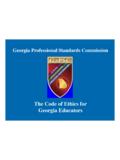Transcription of MODELS FOR CURRICULUM DEVELOPMENT - ed
1 62 MODELS FOR CURRICULUM DEVELOPMENT W. C. HALL INTRODUCTION THERE is increasing interest amongst university teachers in all components of the CURRICULUM process rather than just for the content of a course of study. For example. a recent survey conducted by the Advisory Centre for University Education at the University of Adelaide indicated that the majority of departments thought that course objects arc important, almost all departments are extremely critical of the conventional university examinations which are set, and although lectures are still regarded as generally useful by almost one-half of the departments an equal proportion believe them to be only one of a number of different ways of teaching. Whilst there is some merit in discussing the separate components of the CURRICULUM process ( aims and objectives. content, teach-ing. learning and assessment) it is also important to consider their interrelationships. If this is not done. examinations ru'e in danger of not assessing (implied) course aims, teaching can be relatively inefficient, and learning is accompanied by frustrations on the pan of students.
2 The purpose of this article is to illustrate the relationships between the components of the CURRICULUM process so that the concern which is being shown by university staff for the various parts can be co oordinated to bring about effective changes to the wh ole of a teaching programme. DEVELOPING A SIMPLE MODEL The most common picture of the CURRICULUM used to be that which is shown in Figure I. It illustrates a popularly held belief that education merely consists of facts which have to be examined. In his criticism of graduate education. Rogersl lists ten implied assumptions on which graduate programmes seem to be based. FIGURE i. Popular picture of CURRICULUM * Director of Advisory Centre for University Education, University of Adcll'lide. MODI~ fOR C { DEVELOPMENT 63 Three of these are: (a) The assumption that the ability to pass examinaLions is the best criterion for student se lection and for judging professional promise. (b) Evaluation is education and education is evaluation.}
3 (c) Knowledge is the accumulation of brick upon brick of content and information. All three assumptions are summarised in Figure 1. However, even this inadequate model permits the asking of two fundamental questions by the university teacher: (a) Why am I teaching this? (b) How do I know how successful I have been? The first of these questions deals with content, and the second (indirectly) with examinations. In answering the questions it is necessru'y to consider the validity and significance of what is being taught, the possible need for a balance of breadth and depth, and Lite relevance and interest to the student of the content. The simple model shown in Figure I ignores the possible ways in which learning can take place (for example, generalisation fol-lowed by examples or examples followed by generalisations). The sequencing of subject matter, the cumulative and hierarchical nature o[ some knowledge. and the introduction of unifying concepts must also be considered.]
4 These important aspects will not be ignored if questions like the following are also raised: (c) Why am I teaching this in this particular way? (d) How should I organise the content of my course? The model in Figure 2 allows for questions such as (c) and (d). WAYS OF ORGANISATION TEACHING OF CONTENT CONTENT .J 1 EXAMINATIONS FtGURE 2. An imp"oved CURRICULUM model Although an improvement on Figure I, Figure 2 also neglects important queslions like What books should be used in the course? 64 VESTES (f) Which audio-visual equipment would be helpful? and so Figure 3 is presented as a still further d evelopment. WAYS OF ORGANISATION H TECHNOLOGY I-TEACHING OF CONTENT CONTENT I EXAMINATIONS FIGURE 3. A !u, ther improvement to a CURRICULUM model lVlany teachers are content to stop here. However, the funda-mental question (g) What do I expect students to be able to do, or to beli eve, as a result of my course? is neglected and the answer to this question will help to determine the answers to all of the previous ques tions.
5 Frequently, the question i s ignored. but to ignore it is akin to saying, "Don't worry about the ball, le t's get on with the game." The "ball" is the aims of the course, and these must occupy a central position in any CURRICULUM model, as is shown in Figure 4. WAYS OF TEACHING TECHNOLOGY CONTENT EXAMINATIONS ORGANISATION OF CONTENT FIGURE 4 . A CURRICULUM model This model shows that teaching, course content (and ils sation) and examinations all rely on clearly formulated aims. out a ims, the student becomes rather like Alice: MODELS FOR CURRICULUl\ .. ! DEVELOPMENT 65 "Would you tell me, please, which way I ought to go from here?" "That depends a good deal on where you want to get to," said the Cat. "I don't much care-" said Alice. "Then it doesn ' t matter which way you go," said the Cat. "-so long as ] get somewhere," Alice added as an explanation. "Oh, you're sure to do that," said the Cat, "if you only walk long enough. " THE TYLER RATIONALE The model shown in F igure 4.
6 And the MODELS to be described shortly, all have one thing in common, which i s their dependence on the early work of Ralph Tyler. Twenty-five years ago, R . W. Tyler' produced his course entitled ';Basic Principles of CURRICULUM and Instruction". In it h e iden-Lified four fundamental questions which, h e suggested, should be answered in d eveloping a n y CURRICULUM and plan of instruction. These questions were: I. "Vhat educational purposes should the educational establishment seek to att ain? 2. ''''hat educational experi e n ces can be provided that are likely to auain these purposes? 3. How can th ese educational experiences be effectively organised? 4. How can we determine whether these purposes are being auained? The Tyler rationale (as it h as become known) continues to be Ihe basis o[ llluch o[ the recent CURRICULUM DEVELOPMENT which has taken place. Attempts have been made to extend the list of possible (Iuestions, comparing the CURRICULUM process (for example) with a journey, as is shown below : I.)]]
7 Is th e journey necessary? ~. \Vhcre arc we going? (Aims and objectives) 3. What road do we take? (Subject model) I. What vehicle shall we drive? (Content) ~,. How shall we drive the vehicle? (Approach to learning) 6. What sort of map sh all we provide? (Educational technology) \Vho are our fellow travellers? (Other areas of the CURRICULUM ) Ilow do we tell whether we are on the right track? (Evaluation) Ilow can we tell if we h ave arrived? (Assessment) Ilow do we tell others? (Dissemination) Wha t mistakes did we make? (Feedback) IKJ, CURRICULUM MODELS have been suggested which illustrate the nature of the CURRICULUM process, such as those shown in 5 and 6. 66 VESTES OTHER CURRICULUM MODELS BOlh Kerr3 and Halliwelf4-have suggested MODELS which are directly d erived [rom Tyler. CURRICULUM obiectives K nowledge ~ __ +-_----:;} Curricul um evaluation .1 learning experiences F,GURE 5. Mode l suggested by Kerr (1968) /"'"""\ Aims Assessment ~ Mi''' '"' / FIGURE 6.]
8 Halliwell's (1968) 1A's Halliwell's model is particularly interesting because it implies that the CURRICULUM developer need not start with aims. A wcakne~s of both mode ls is the implication that all of the outcomes of an educational process are amenable to evaluation (or This is not (al the present moment' in time) true. For e"a",ple, IHany attitudinal aims cannot be reliably assessed; and many larH course aims are long-term "hopes" which are only "., achieved at u ni versity. A more realistic model would appear to that shown in Figure 7. MODELS FOR C URRICULUM DEVELOPMENT /Hopes~ Goals Teaching ~ and learning Aims ~ Objectives < 1 '4 Evaluate -----"and assess~ Modify FIGURE 7. A 1nodel /01' the CURRICULUM process 67 Figure 7 assumes that "goals" are the general outcomes of a course of study. Some of these are translated into long term hopes C .. to produce a professional doctor") and others into more detailed aims which are applicable to the whole of a course.
9 These are the aims which are assessed ( by examination). By assessment one means "HoW' successfully have students achieved the course aims?" ; evalu-alion covers the efficacy of teaching, feedback from students, and evalua tion of the assessment procedures. Finally, the model recognises that in most teaching programmes specific objectives are rarely formally assessed. For practical pur poses it is course aims that form the basis of an examination. THE AIMS OF A COURSE \Vhcn aims are being selected, the CURRICULUM developer must take account of a number of "pressures", including: (a) the DEVELOPMENT (social, psychological, physical and emotional) o[ the student; (b) the nature of the subject being taught; (c) the requirements of the consumer ( business and industry) ; (d) restramts ( cultural and economic) imposed by resources; (e) the competen ce of the teaching staff. If the~ pressures are ignored, a course can be produced which is both difficult to effect and is irrelevant to the student.]
10 OBJECTIVES F~r ay teaching purposes, aims must be turned into speafic lcaching objectives. These objectives are not a list of things 10 learn, they are not a syllabus (in the accepted sense of the term) and they say nothmg about the teaching approach Objectives show "hat a sludent should be able to do as a res~lt of a learning 68 VESTES MagerS gives the following characteristics of a "behavioural" objective: I. They sp ecify the kind of behaviour which will be accepted as evidence that the learner has achieved the objective. 2. They describe lhe important conditions under which the be. haviour will be expected to occur. 3. They describe how well the learner must perform to have his behaviour considered acceptable. In phrasing objectives, certain terms ( to know, to understand, to appreciate, to be concerned) are open to many interpretations and so are probably best not used. More suitable terms, which are open to fewer interpretations, include: to write, to recall, to solve, to list.











